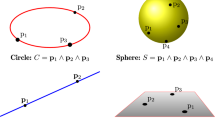Geometric algebra is currently not a widespread mathematical tool in the fields of computer vision, robot vision, and robotics within the engineering sciences, where standard vector analysis, matrix algebra, and, at times, quaternions are mainly used. The prevalent reason for this state of affairs is probably the fact that geometric algebra is typically not taught at universities, let alone at high-school level, even though it appears to be the mathematical language for geometry. This unfortunate situation seems to be due to two main aspects. Firstly, geometric algebra combines many mathematical tools that were developed separately over the past 200-odd years, such as the standard vector analysis, Grassmann's algebra, Hamilton's quaternions, complex numbers, and Pauli matrices. To a certain extent, teaching geometric algebra therefore means teaching all of these concepts at once. Secondly, most applications in two- and three-dimensional space, which are the most common spaces in engineering applications, can be dealt with using standard vector analysis and matrix algebra, without the need for additional tools. The goal of this text is thus to demonstrate that geometric algebra, which combines geometric transformations with the construction and intersection of geometric entities in a single framework, can be used advantageously in the analysis and solution of engineering applications.
Matrix algebra, or linear algebra in general, probably represents the most versatile mathematical tool in the engineering sciences. In fact, any geometric algebra can be represented in matrix form, or, more to the point, geometric algebra is a particular subalgebra of general tensor algebra (see e.g. [148]). However, this constraint can be an advantage, as for example in the case of quaternions, which form a subalgebra of geometric algebra. While rotations about an axis through the origin in 3D space can be represented by 3 × 3 matrices, it is a popular method to use quaternions instead, because their components are easier to interpret (direction of rotation axis and rotation angle) and, with only four parameters, they are a nearly minimal parameterization. Given the four components of a quaternion, the corresponding (scaling) rotation is uniquely determined, whereas the three Euler angles from which a rotation matrix can be constructed do not suffice by themselves. It is also important to dene in which order the three rotations about the three basis axes are executed, in order to obtain the correct rotation matrix. It is also not particularly intuitive what type of rotation three Euler angles represent. This is the reason why, in computer graphics software libraries such as OpenGL [23, 22], rotations are always given in terms of a rotation axis and a rotation angle. Internally, this is then transformed into the corresponding rotation matrices.
Access this chapter
Tax calculation will be finalised at checkout
Purchases are for personal use only
Preview
Unable to display preview. Download preview PDF.
Similar content being viewed by others
Rights and permissions
Copyright information
© 2009 Springer-Verlag Berlin Heidelberg
About this chapter
Cite this chapter
(2009). Introduction. In: Geometric Algebra with Applications in Engineering. Geometry and Computing, vol 4. Springer, Berlin, Heidelberg. https://doi.org/10.1007/978-3-540-89068-3_1
Download citation
DOI: https://doi.org/10.1007/978-3-540-89068-3_1
Publisher Name: Springer, Berlin, Heidelberg
Print ISBN: 978-3-540-89067-6
Online ISBN: 978-3-540-89068-3
eBook Packages: Computer ScienceComputer Science (R0)




